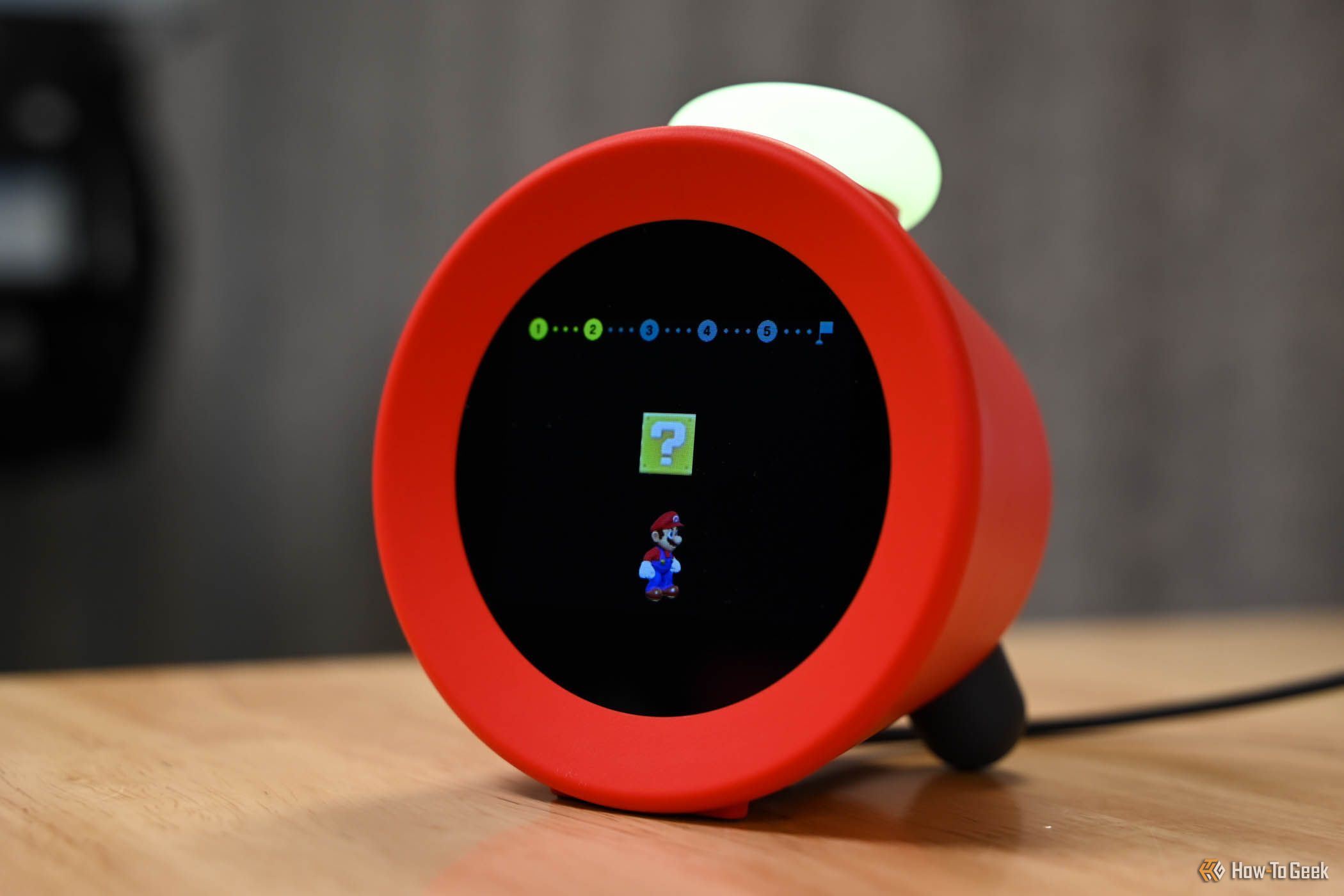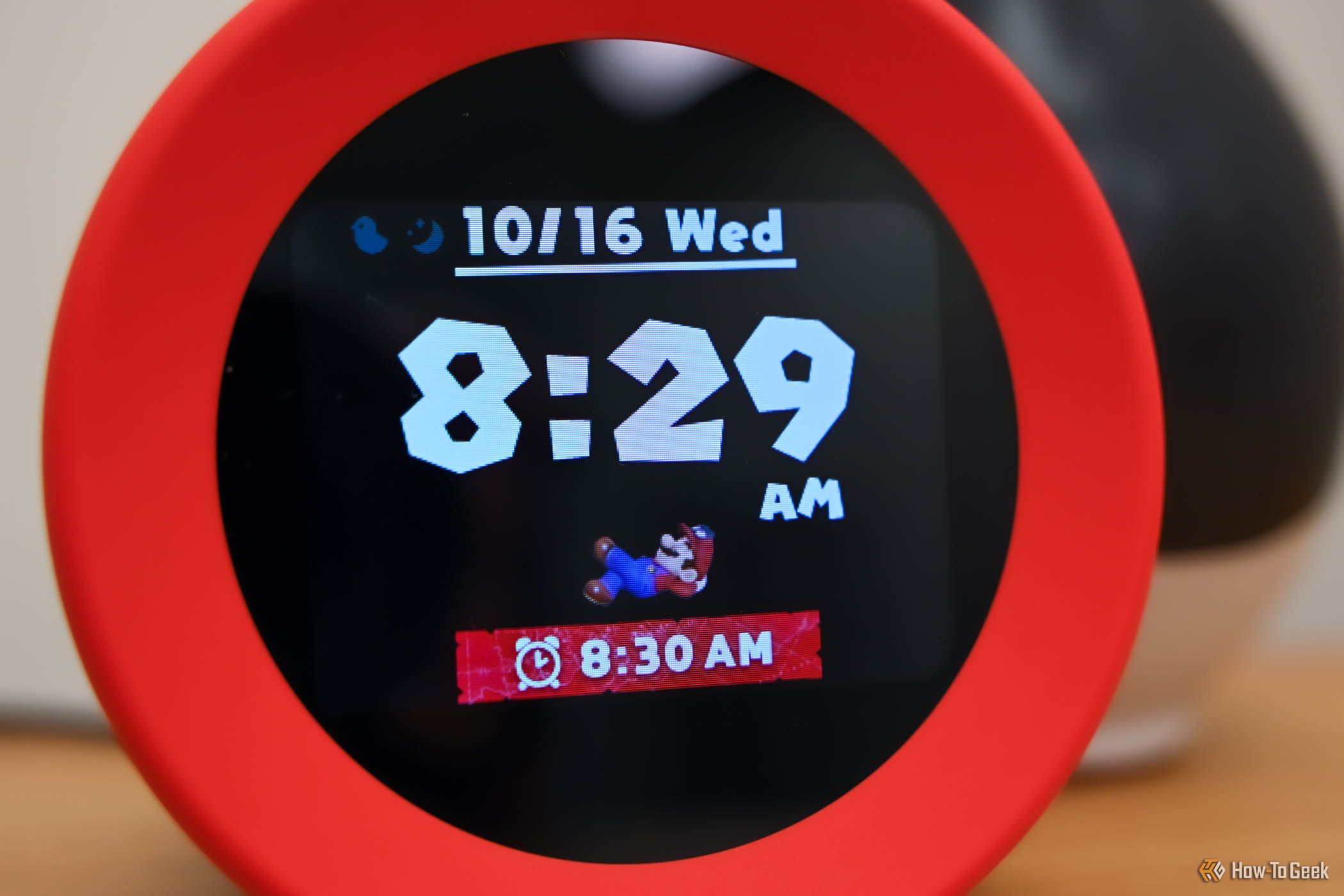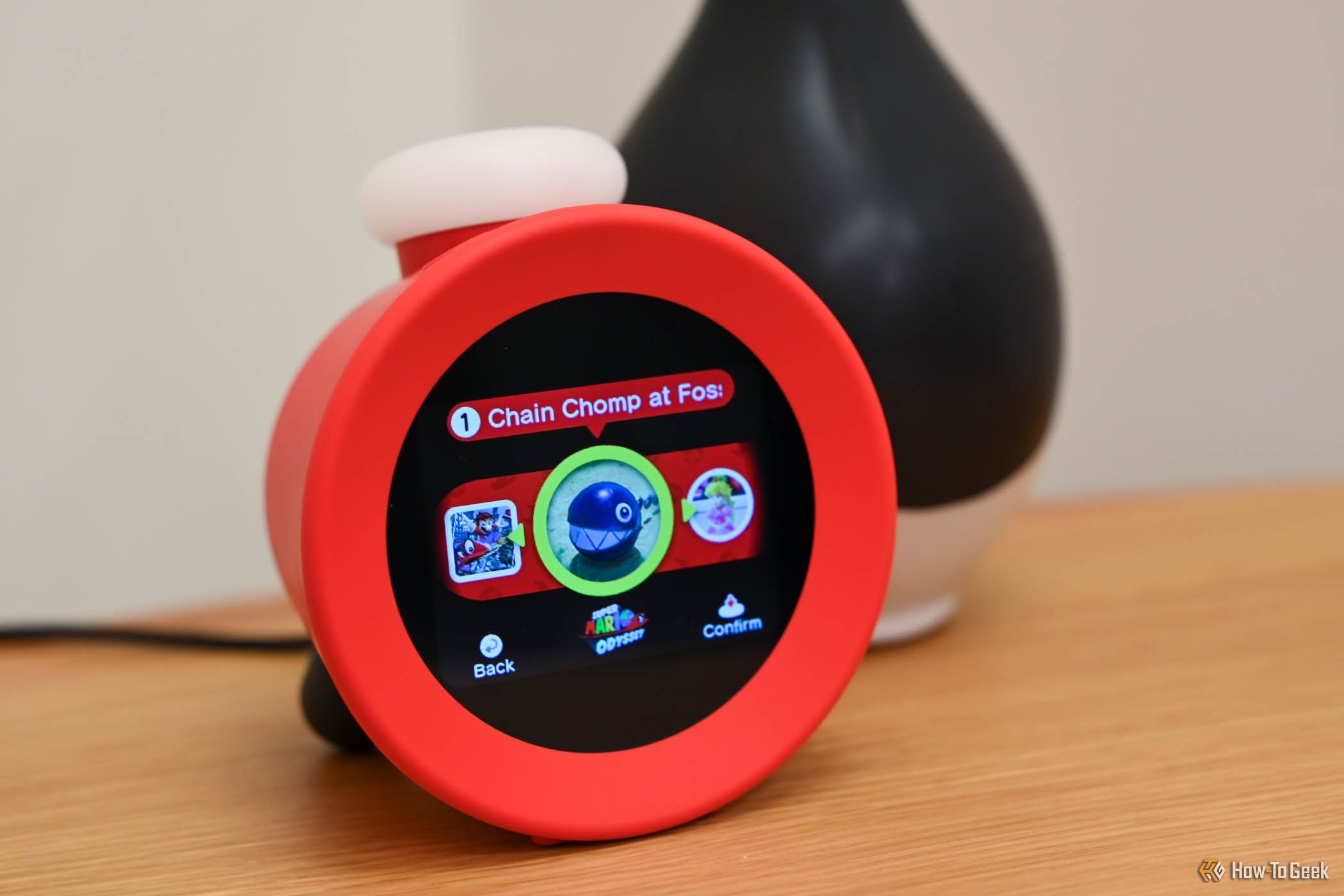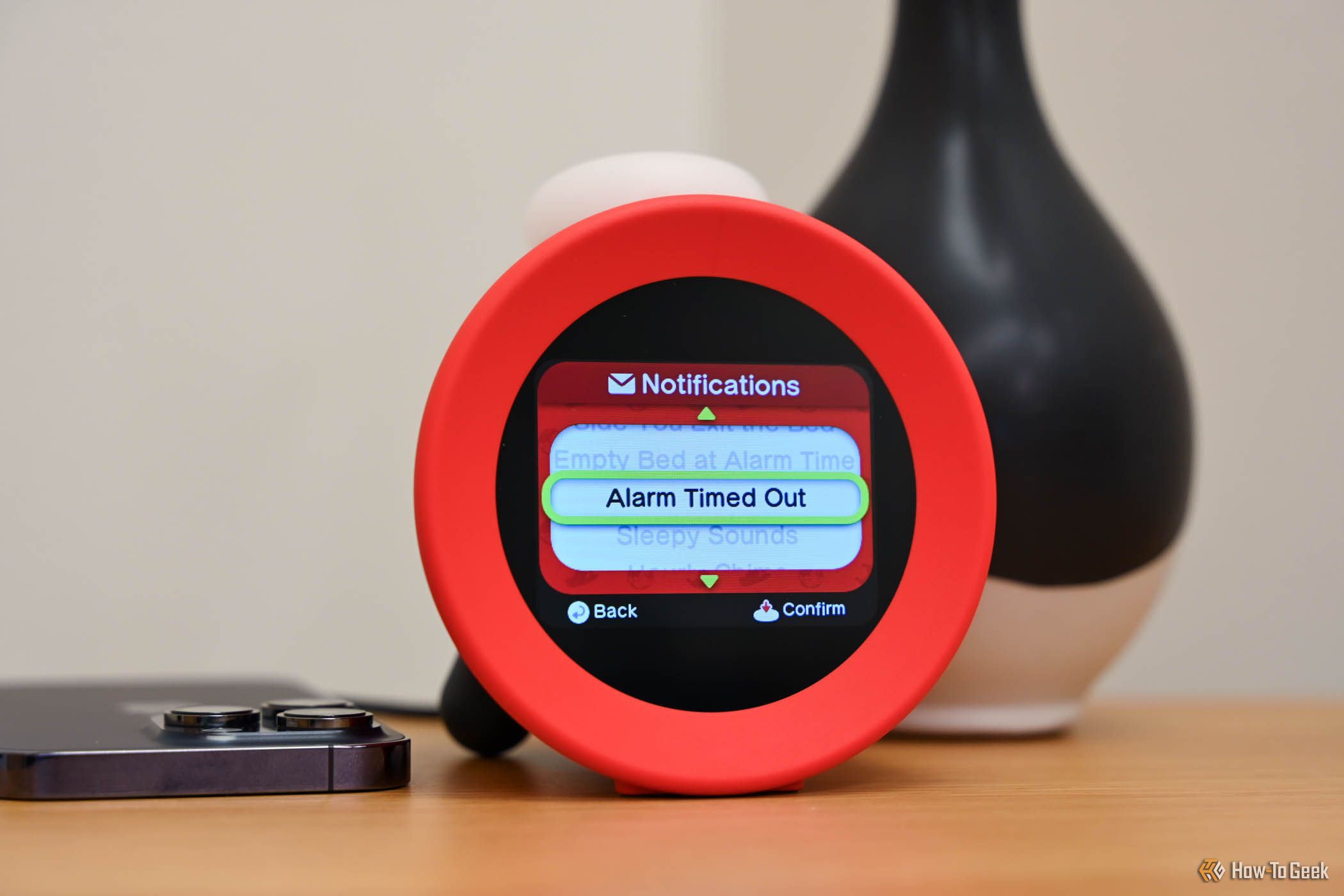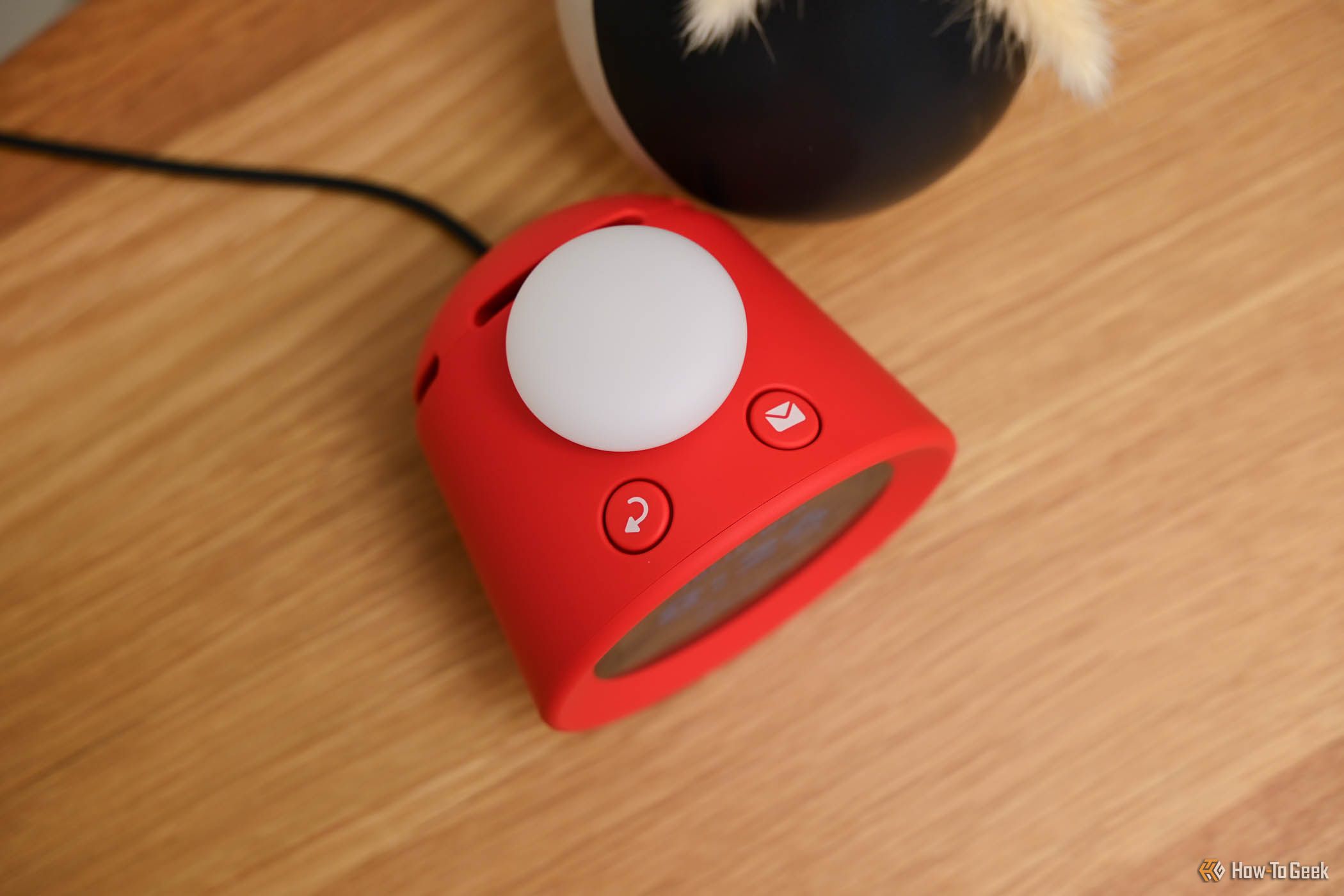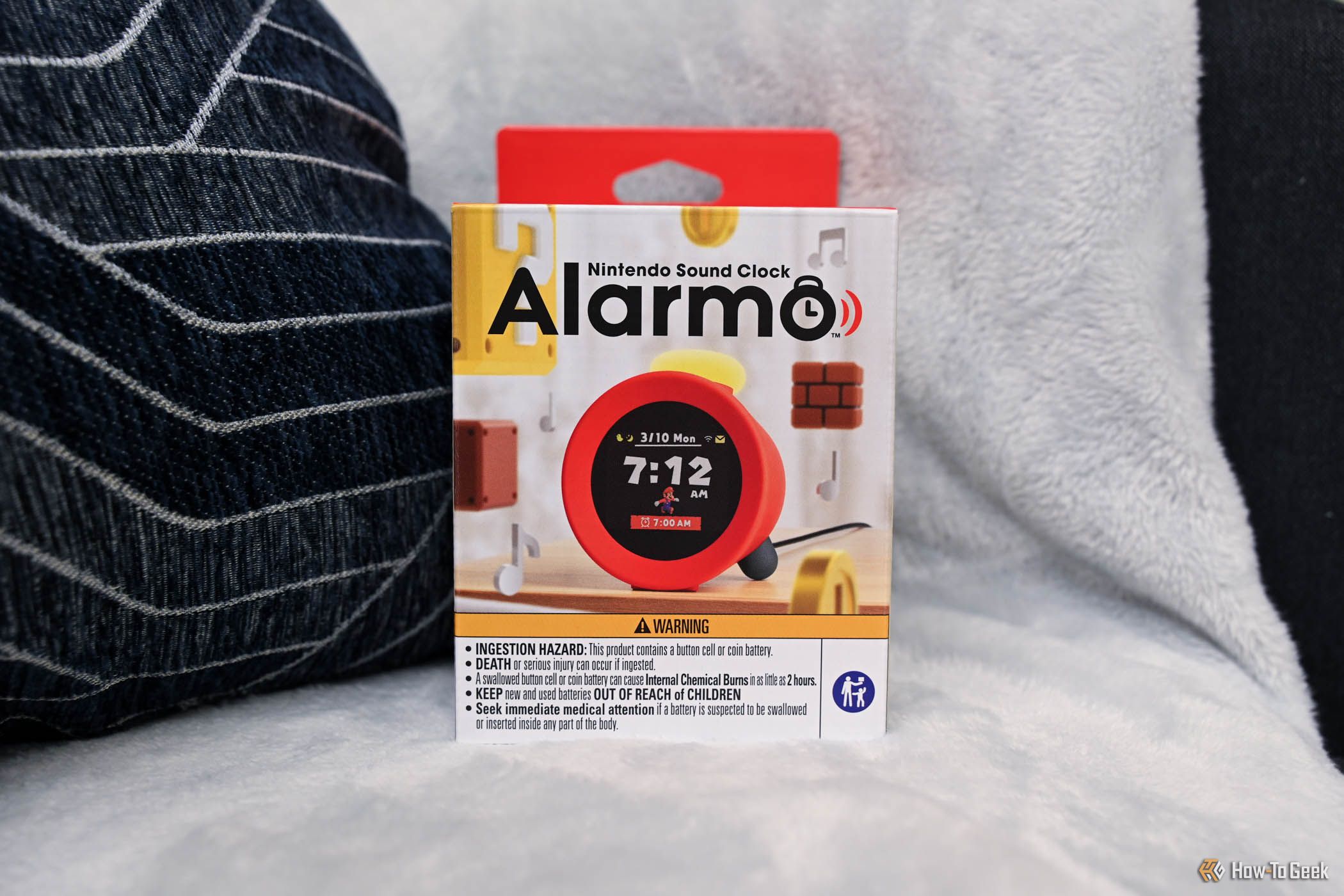Key Takeaways
- Nintendo Alarmo is an alarm clock featuring Nintendo characters and motion sensors that activate sound effects while the alarm goes off.
- There are charms to the hardware and presentation, but the gimmicks grow tiresome quickly.
- The clock lacks a diverse selection of games, has poor screen brightness, and only works properly with one person.
The premise of Nintendo Alarmo makes sense when you think about it. The alarm cock hearkens back to Nintendo’s toy-making days while also fitting into its initiative to create lifestyle products. Unfortunately, this attempt to integrate the likes of Mario and Link into fans’ bedtime doesn’t quite reach the top of the flagpole.
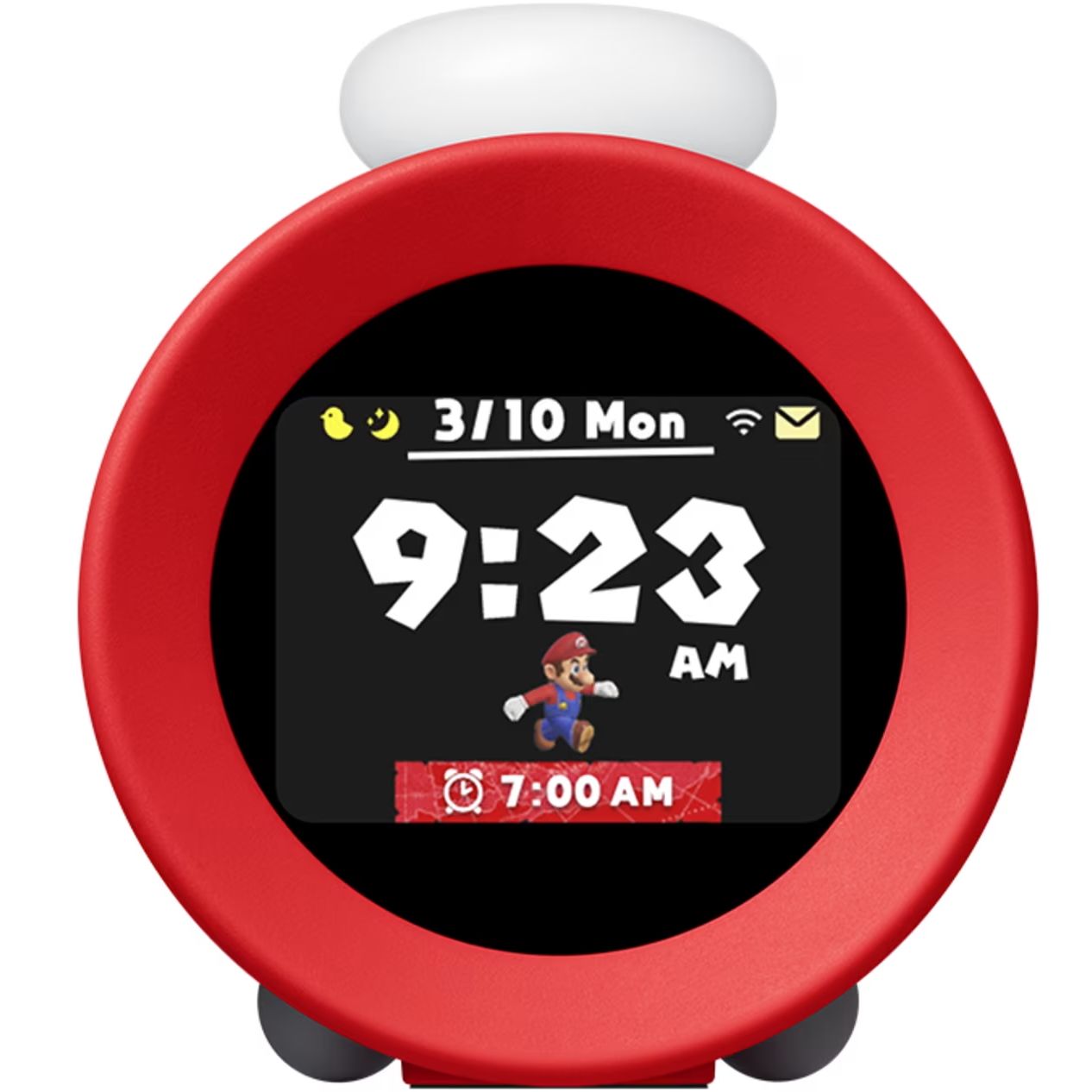
Nintendo Alarmo
Nintendo Alarmo is an alarm clock featuring characters and alarm themes from Nintendo games. It uses motion sensors to add sound effects to alarms and provide a hands-free experience.
- Display Type
- 2.8-Inch LCD
- Power Source
- USB-A (power adapter not included)
- Batteries required?
- No
- Nintendo characters and music are charming
- Bedtime music is soothing
- Good speaker quality
- Missing many popular Nintendo franchises
- Lacks animation and music variety
- Motion sensor gets confused by pets and bed partners
- No power adapter
Price and Availability
Nintendo Sound Clock: Alarmo comes packaged with a USB-C to USB-A cable and retails for $99.99. There’s no power adapter included, so you’ll need one—or an outlet with a USB-A port—in order to use the clock (it doesn’t run on battery, so it needs to be plugged in at all times).
Specifications
- Display Type
- 2.8-Inch LCD
- Power Source
- USB-A (power adapter not included)
- Batteries required?
- No
Why Did Nintendo Make an Alarm Clock?
While the Internet expressed genuine surprise at the announcement of the Nintendo Alarmo, the concept has been in the works since the late Nintendo president Satoru Iwata’s historic tenure.
Iwata himself announced the company’s initiative for “non-wearable” lifestyle products to investors in 2014. The following year, mock-ups appeared of potential products, including a clock (albeit one very different from the Alarmo). Developments have been largely quiet since then, with the closest cousin to the initiative being the Pilates ring-controlled Nintendo Switch game Ring Fit Adventure.
It’s also the perfect year for the Alarmo to hit the shelves just in time for a holiday season when Nintendo is between console generations and doesn’t have a new blockbuster game. While the Alarmo’s cost is prohibitive as a personal purchase for many, it’s more palatable as a gift.
Charm With a Short Shelf Life
The Nintendo Alarmo makes a strong impression out of the box. Its red, ring-shaped body and translucent bulb atop it look like something the company would’ve created before its video game era. It also has a sturdy build quality, clicky buttons, and a well-placed USB-C port that keeps the cable out of sight.
Once set up, the charms continue with five clock faces based on five Nintendo games: Super Mario Galaxy, The Legend of Zelda: Breath of the Wild, Splatoon 3, Pikmin 4, and Ring Fit Adventure. Each changes the clock’s typeface to match the game with the protagonist walking back and forth across the screen, occasionally performing one of a handful of possible animations, including hourly chimes that sync up with lights in the bulb.
Unfortunately, the limitations of the character implementations fold under minimal scrutiny. The canned walk cycle and idle animations are jerky and aimless, while the hourly chimes quickly feel grating upon repetition (though they can be toggled off). Also, for included games wherein players pick the gender and race of their character (Splatoon 3 and Ring Fit Adventure), Alarmo doesn’t provide any such personalization—you’re stuck with a female Inkling and a male athlete. And perhaps most disappointingly, no element is interactive, which feels like it should be the cornerstone of any video game clock.
Of course, the real reason to own a themed alarm clock is for its alarms. There are seven themes for each of the five games, as well as options to randomize them daily by game or altogether. Further, there are four settings for how the alarm functions: Gentle, Moderate, and Steady modes (which dictate the intensity of the alarm), and Button Mode, where you can stop the alarm by pressing the top button.
The first three options use the clock’s motion sensors to create a unique wake-up experience. Moderate Mode starts off with more calming sounds before ratcheting up the liveliness of the music, with the Gentle and Steady Modes maintaining either end of that spectrum. You can move your body or hand-wave away the music for a short period before it returns, and each motion plays a game-appropriate sound effect.
After 20 minutes in Moderate and Steady, harsher music (such as a boss theme) will take over as the clock tells you to “hurry up.” Getting out of bed stops this cycle, while getting back into bed within an hour of the alarm going off will revive the cacophony. If you want the clock to stop bothering you completely, you can turn it off with the button.
It’s a fun gimmick for a few mornings, especially with the handful of themes that perfectly lend themselves to the format, such as Zelda pleading, “Wake up, Link, open your eyes,” and a gradual big band buildup to Super Mario Odyssey’s “Jump Up, Super Star!” The speaker quality is good enough to present these tracks in an appealing manner, too.
Yet even as a lifelong Nintendo fan, a barrage of familiar music and sound effects became a nuisance after repetitive days of use. The sound effects also overpower the music, which makes it hard to appreciate the core tunes. You’d be better off setting the songs to play as your phone’s alarm tone.
However, I enjoyed the Sleepy Sounds feature far more than I anticipated. These are relaxing tracks from each game that automatically play when the motion sensors detect movement after your set bedtime. Think of them as lo-fi beats to sleep to. They were pleasing transitions to sleeping that didn’t overstay their welcome, even if the lack of variety among them hinders the long-term value of the feature. It was in this feature that I could see the promise of Nintendo’s franchise-forward approach to lifestyle products.
Many of Your Nintendo Favorites Aren’t Here
There are only themes from five games available for the Alarmo’s launch, with Animal Crossing: New Horizons and Mario Kart 8 announced as free post-launch downloads. You’re in for a treat if these are the franchises you love, but this barely scratches the surface of Nintendo’s modern output, let alone their iconic catalog.
Given that each theme comprises just a few images, sounds, and songs, the size of this selection feels woefully underwhelming. Many of Nintendo’s best-selling and most acclaimed franchises, such as Kirby, Metroid, and Donkey Kong are missing, and there are no odes for older generations. Retro themes for the NES and SNES would’ve really helped sell the Alarmo as a celebration of Nintendo, for example. A little effort would have gone a long way, but instead, we got what I’d consider below the bare minimum.
This isn’t to say that I’m docking the game for not including my ideas, but rather that Nintendo has the potential to offer so much more than they are. This is a product that’s going to appeal to die-hard fans but fails to service that demographic. The clock does have a prominently featured “download new alarms” feature, so hopefully with time this will cease to be an issue, but that doesn’t change a scarce launch lineup that’s all too reminiscent of the drip-feed strategy the company often employs.
The Screen and Software Need a One-Up
I noted my appreciation for the form factor of the Alarmo earlier, but one critical component that left me disappointed was the 2.8-inch rectangular LCD screen that sits in the middle of the clock’s face. Not only does it jarringly break up the aesthetic of the Alarmo and limit the potential of what could’ve been done with a circular screen, but it’s also notably dimly lit on the highest brightness setting.
The likely culprit here is a poor implementation of the brightness sensor, which keeps the screen from being distracting at night but isn’t equally adjusted to make it legible under lights.
Meanwhile, the horizontal menus that you navigate by turning and pressing the bulb on top of the clock get the job done but can become very choppy, especially when scrolling through alarm themes. This is a bit concerning as it could become unwieldy if not optimized before Nintendo adds more games to the system. However, in most other places, the control scheme works smoothly.
There are aspects of the software that are currently useless or are questionable inclusions given its quality. The notification button on the top of the clock currently serves up daily tutorials but hasn’t been used for any communication from Nintendo. I assume it’ll let Alarmo owners know new themes are available to download, but that button would’ve been better served directing users to the alarm settings.
The clock also features statistics on how long you sleep, how much you move in bed, and how long it takes you to wake up from an alarm. None of this is particularly useful, given that the clock interface isn’t a good way to parse this data. The sleep tracker also doesn’t offer anything insightful as it simply states when it senses you get into bed and when your alarm goes off. Even then, I got clearly incorrect results, such as a day it recorded me as sleeping for 22 hours (I wish).
It’s also worth noting that the Alarmo’s setup process is fairly lengthy for an alarm clock. I had no issues with it, but other How-To Geek staff members noted frustrations. It requires enough work, and kids will likely need a parent to help them set the clock up.
Only For Single Players
The Alarmo’s motion sensors do a good job of tracking your body movement, but that ceases when you have another person or a pet sharing the bed.
In my experience, the alarm cycle will continue until everyone is out of bed, and pets who get back into bed will also set the alarm off again. This can be worked around by turning on Button Mode, in which the Alarmo functions like a traditional alarm clock. However, since this clock’s unique attributes are built around motion tracking, it defeats much of its purpose. This is so much the case that the box even warns against it.
Should You Buy a Nintendo Alarmo?
The Nintendo Alarmo could be a fun alarm clock with more themes and a lower price, especially for kids. However, at $100, it’s simply too expensive for what it currently offers, and even with more themes, it still may not make up for the areas it falls short in. The only people I can recommend this to are collectors who want to own a quirky piece of Nintendo history and gift-buyers in desperate need of a Nintendo-related item that most people aren’t likely to already own.

Nintendo Alarmo
Nintendo Alarmo is an alarm clock featuring characters and alarm themes from Nintendo games. It uses motion sensors to add sound effects to alarms and provide a hands-free experience.

